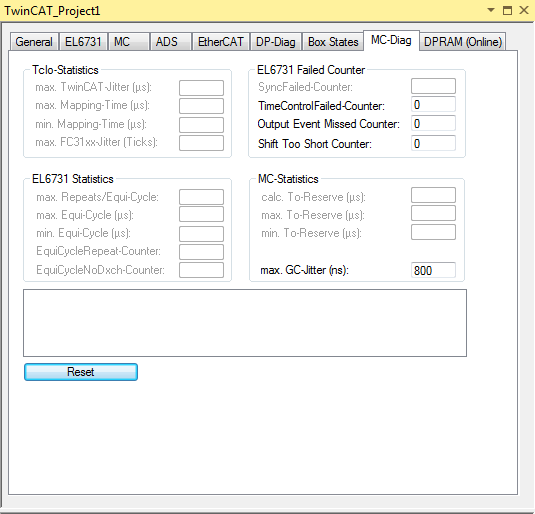MC-Diag
Various monitoring parameters for Equidistant mode are displayed on the "MC-Diag" tab.

"max. TwinCAT-Jitter (µs)" text box
The "max. TwinCAT-Jitter (µs)" text box contains the largest TwinCAT jitter measured since the start of the measurement in microseconds.
"max. Mapping-Time (µs)" text box
The "max. Mapping-Time (µs)" text box shows the largest NC access time measured since the start of the measurement in microseconds. In addition to the mapping time, the NC access time can also contain the task runtime. The mapping time is the time for mapping process data
to the PROFIBUS. The task runtime is included in the NC access time when the I/O update for the synchronizing task is performed at the end of the task. The NC access time should be greater than the sum of the largest TwinCAT jitter measured since the start of the measurement, the largest mapping time measured since the start of the measurement and, if applicable, the task runtime or the NC task runtime. The NC access time should be set with a safety margin of around 10%.
"min. Mapping-Time (µs)" text box
The "min. Mapping-Time (µs)" text box shows the smallest NC access time measured since the start of the measurement in microseconds. In addition to the mapping time, the NC access time can also contain the task runtime. The mapping time is the time for mapping process data
to the PROFIBUS. The task runtime is included in the NC access time when the I/O update for the synchronizing task is performed at the end of the task. The NC access time should be greater than the sum of the largest TwinCAT jitter measured since the start of the measurement, the largest mapping time measured since the start of the measurement and, if applicable, the task runtime or the NC task runtime. The NC access time should be set with a safety margin of around 10%.
"max. FC31xx-Jitter (Ticks)" text box
The "max. FC31xx-Jitter" text box contains the largest jitter of the FC card measured since the start of the measurement in microseconds.
"max. Repeats/Equi-Cycle" text box
The "max. Repeats/Equi-Cycle" text box shows the maximum number of data exchange telegrams that have been repeated during an Equi-Cycle since the start of the measurement. If data exchange telegrams are repeated, the Equi-Cycle is extended. If, for example, a bus plug has not just been removed or an MC slave device has not just been switched off, no repetitions should occur for the data exchange telegram.
"max. Equi-Cycle (µs)" text box
The "max. Equi-Cycle (µs)" text box contains the largest Equi-Cycle time in microseconds measured since the beginning of the measurement.
"min. Equi-Cycle (µs)" text box
The "min. Equi-Cycle (µs)" text box contains the smallest Equi-Cycle time in microseconds measured since the beginning of the measurement.
"EquiCycleRepeat-Counter" text box
The "EquiCycleRepeat-Counter" text box shows how often telegrams have been repeated in the Equi-Cycle since the beginning of the measurement.
"EquiCycleNoDxch-Counter" text box
The "EquiCycleNoDxch-Counter" text box shows how often MC slave devices have not been exchanging data in the Equi-Cycle since the start of the measurement.
"SyncFailed-Counter" text box
In the "SyncFailed-Counter" text box the number of occurrences is counted at which the synchronizing TwinCAT task and the DP cycle have not been synchronized since the start of the measurement. Lack of synchronization can occur during TwinCAT system start-up; subsequently this counter should no longer increment. If the synchronizing task does not have the highest priority, this counter may also increment, which should be avoided.
"TimeControlFailed-Counter" text box
In the "TimeControlFailed-Counter" text box the number of occurrences is counted at which the PROFIBUS was not free at the time of the start of a DP cycle since the start of the measurement. This can be caused by bus faults, non-existent devices or a second master device.
"Output Event Missed Counter" text box
"Shift Too Short Counter" text box
"calc. To-Reserve (µs)" text box
In the "calc. To-Reserve (µs)" text box the calculated To-Reserve time is entered in microseconds. It is calculated as follows: To-Reserve = To-Time – Equi-Cycle-Time.
"max. To-Reserve (µs)" text box
In the "max. To-Reserve (µs)" text box, the largest To-Reserve time calculated since the start of the measurement is entered in microseconds.
"min. To-Reserve (µs)" text box
In the "min. To-Reserve (µs)" text box, the smallest To-Reserve time calculated since the start of the measurement is entered in microseconds.
"max. GC-Jitter (ns)" text box
In the "max. GC-Jitter (ns)" text box the largest jitter measured since the start of the measurement is displayed in nanoseconds. The jitter may be slightly larger during startup. In steady state, the jitter should not exceed 1 microsecond if the PROFIBUS cycle is synchronized.
"Reset" button
Pressing the "Reset" button resets the measured values, and a new start of the measurement is defined for the values displayed in this dialog.